New Tool Helps Engineers Consider Carbon Emissions During The Design Process


(Image: Colton Duke/Unsplash)
When you think about major sources of greenhouse gas emissions, you probably think about carbon dioxide emissions resulting from energy production, or transportation. It goes without saying these are huge drivers. But you might not think about embodied emissions from the construction of the world's infrastructure.
Embodied carbon from new infrastructure is expected to be responsible for half of the global carbon footprint between now and 2050, Savina Carluccio, executive director of the International Coalition for Sustainable Infrastructure, said in a statement.
Embodied carbon is the emissions associated with the extraction, production, transport, and manufacturing of all building materials before on-site construction even begins. Before a piece of infrastructure is in use, carbon is already embodied in these building blocks.
With the built environment contributing so significantly to greenhouse gas emissions, accurately accounting for embodied carbon is increasingly urgent. Yet, it is historically painstaking to do and often overlooked.
Infrastructure engineering software company Bentley Systems announced its Carbon Analysis tool earlier this month at the company’s annual Year In Infrastructure conference. The tool aims to make carbon accounting much easier, much faster, and importantly, even assist engineers in mitigating the carbon footprint of their infrastructure projects.
TriplePundit was invited to attend the event, where we spoke with Chris Bradshaw, Bentley Systems’ chief sustainability officer, about the tool and how it fits in with the company’s sustainability goals.
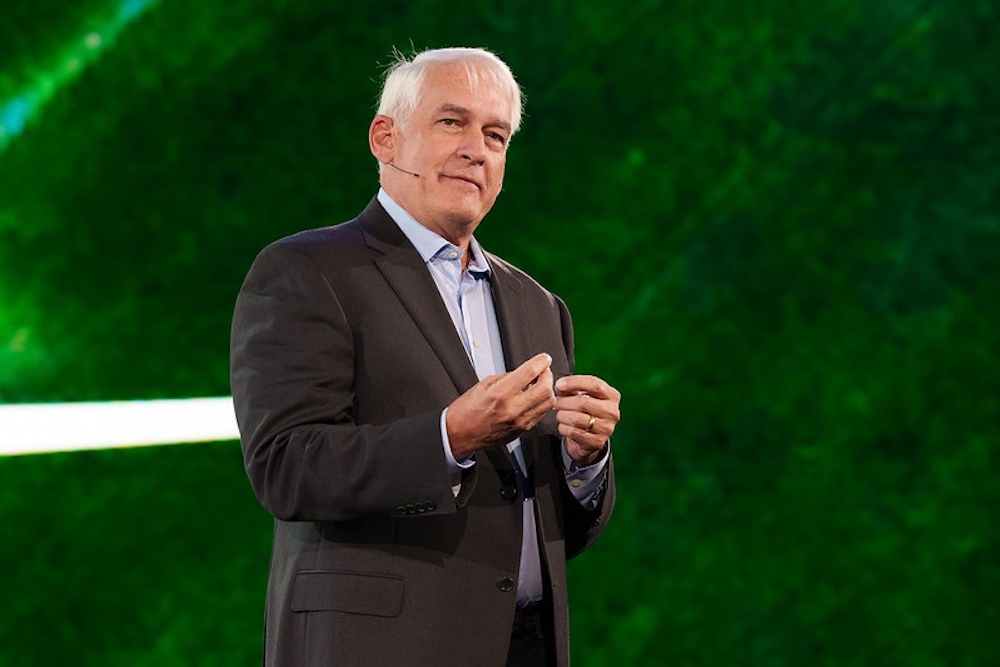
Bentley Systems’ software is used globally to design, operate and maintain all kinds of infrastructure projects — anything from roads, bridges, wind farms, dams and any type of building. As part of the design process, engineers build virtual models of their projects using the software and, increasingly important within the industry, create digital twins. A digital twin is an accurate virtual rendering of something in the physical world.
Digital twins are distinguished from decades-old computer-aided design or simulation software because they are linked to numerous data sources throughout the lifecycle of design, build and operational phases. So the model is continually updated in real-time. This allows for far greater accuracy, letting designers and engineers modify the digital twin to predict how any changes they make will manifest in the real world.
Digital twins can incorporate artificial intelligence tools, as well, to further enhance their power as engineers test among different design scenarios. Important too, they provide a holistic representation, rather than keeping information in separate silos.
Bentley Systems’ new Carbon Analysis tool dovetails with the company’s artificial intelligence-powered digital twin software, iTwin Experience. The pair simplifies carbon reporting by allowing engineers to compile carbon reports concurrently with the design process. This improves upon the traditional approach, where reporting is typically a laborious additional task that might take weeks or months to compile.

With the new Carbon Analysis tool, engineers can quickly map their project materials data to a third-party carbon calculator of their choice. And because the tool makes this simple to do, engineers can compare material and design choices for whatever they are building to see how different options increase or decrease embodied carbon in real-time.
“Sustainable development occurs when you balance perfectly the environment, the economic and the social impact,” Bradshaw said. “We see, fundamentally, a digital twin being the mechanism to help do that.”
Bradshaw used an example from his hometown to explain how this balancing act might look.
“We have a bridge, which goes over a small body of water,” Bradshaw said. “It is made of wood, it’s historical and people love it. But the thing’s falling apart. The county said they’re going to replace it with concrete and steel, and the community was up in arms saying, ‘No, we want another wooden bridge.’ So now you are in a conversation about what you are trading off. With a digital twin, you can scenario-optioneer to your heart’s content.”
Let’s say the county uses Bentley Systems’ software. It could create a digital twin of each bridge option. One in concrete and steel, and another from wood. Using the new tool, it could very quickly determine the embodied carbon of either option, while simultaneously representing aesthetic and functional requirements.
And since the tool creates a three-dimensional heat map of where concentrations of embodied carbon are found in a design, the visual rendering points to possible opportunities to mitigate embodied carbon. Three-dimensional visualization provides a secondary benefit, as well.
“It allows non-engineers to participate in the conversation, too,” Bradshaw said. “As you can visualize in a way that everyone gets to understand.”
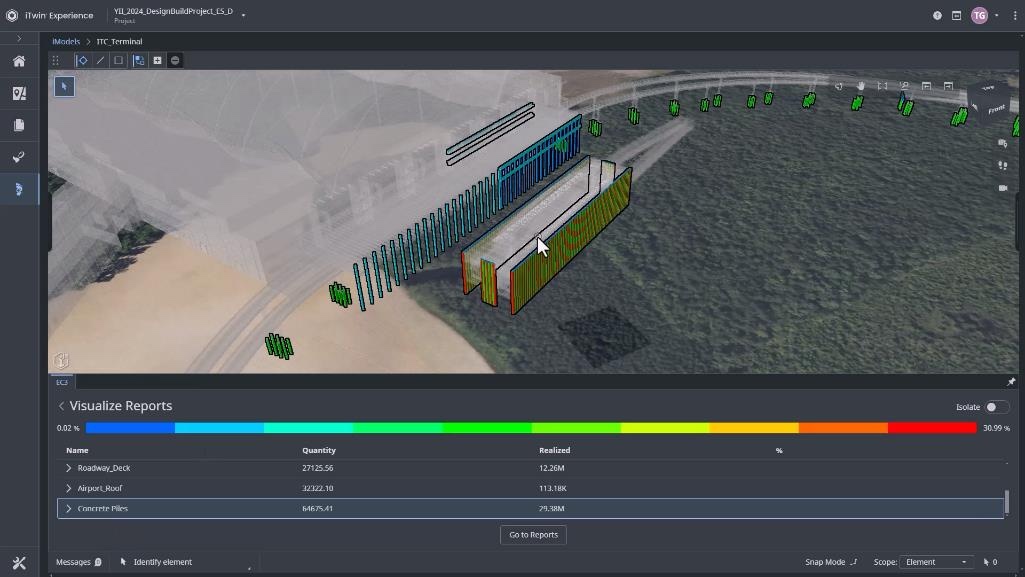
Of course, what actually gets built is subject to a range of factors, so the Carbon Analysis tool won’t force owners of a project to reduce the carbon footprint. And easy carbon reporting doesn’t mean owners of infrastructure projects will necessarily make carbon mitigation a focus. But as Bradshaw said, “The good news is, infrastructure owners are getting more savvy to it.”
The company is incorporating the new tool into its digital twin product at no additional cost.
“We took that path because we feel very strongly that this is something that the world needs to do,” Bradshaw said. “So we don’t want to create a price barrier to our users in being able to do these calculations.”
Perhaps in the future, though, engineers won’t have a choice. Bradshaw said he thinks infrastructure engineers will increasingly have to properly account for embodied carbon.
“All infrastructure in the world is either owned by governments or regulated by governments,” Bradshaw said. “Because of that, governments can accelerate the evolution to more sustainability and resilience through regulations or contract requirements. So far, not enough, but I think this will change on a year-to-year basis.”
Whatever the regulatory framework looks like going forward, there are benefits to using digital tools, Mark Coates, the company’s international director of public policy and advocacy, told 3p at the event.
He built upon the age-old maxim: measure twice, cut once. Instead, “Build digitally, two, three, four times. You make fewer mistakes, increase the chance of being on time and under budget, and you use less carbon because of reduced mistakes while promoting best practices.”
Editor's Note: Travel and accommodations to Vancouver, Canada, were provided by Bentley Systems. Neither the author nor TriplePundit were required to write about the experience.
Ocean Biodiversity is Under Threat and Technology Can Help Save It


(Image: Michael Worden/Unsplash)
The Pacific Ocean off the coasts of Central and South America is home to some of the richest concentrations of biodiversity on Earth, a haven for marine life ranging from whales, sharks, dolphins and sea turtles to vibrant corals, dense schools of pelagic fish and tiny phytoplankton.
Marine life is so abundant here that in 2004 the governments of Colombia, Costa Rica, Ecuador and Panama signed a declaration to establish the Eastern Tropical Pacific Marine Corridor, also known as CMAR, to connect their unique marine protected areas (MPAs) and safeguard the migratory pathways between them.
The creation of CMAR is no small accomplishment coming at a time when our ocean’s future is increasingly under threat. Today, our planet’s ocean remains in uncharted territory amid a dramatic combination of climate change, pollution, and illegal, unreported and unregulated fishing. According to the United Nations, the picture is stark: 90 percent of the planet’s big fish populations are depleted while 50 percent of coral reefs are destroyed. Marine biodiversity — and the ocean itself — has reached a tipping point.
A tipping point, however, is a far cry from a point of no return. Over the past 20 years, CMAR’s growing successes have seen it double in size, expanding from an initial five MPAs to 10 — a formidable cluster that includes renowned biodiversity hotspots such as Cocos Island and the Galápagos Islands and now spans some 2 million square kilometers of ocean.
This is a triumph for CMAR and the four Latin American nations that founded it and represents a critical step in the right direction for global marine conservation. Many peer-reviewed studies, show that creating large MPAs and ensuring wildlife can move among them has enormous benefits, not only within those areas but for nearby fisheries, as well. Research also shows that well-protected MPAs are more resilient than other areas to the effects of climate change, and that those benefits also extend beyond MPA boundaries.
These safeguards are crucial to achieving the global goal of protecting at least 30 percent of the ocean by 2030, known as the 30 by 30 target, which the 196 member countries of the Convention on Biological Diversity agreed to in December 2022.
But CMAR’s work in protecting ocean biodiversity is not only a victory for marine conservation, it is also a clarion call for the role of digital innovation in delivering sustainable ocean governance. It is one thing to pledge safeguards to ocean biodiversity and quite another to ensure them by monitoring and enforcing rules across vast swathes of open ocean.
CMAR has the right tools in its conservation toolbox to do both. Since 2022, the intergovernmental initiative has partnered with Global Fishing Watch, an international nonprofit organization working to map all human activity at sea, to strengthen its ability in effectively managing and monitoring its MPAs through cutting-edge technology and data.
By leveraging satellite imagery, machine learning, and human expertise for gathering and interpreting data, Global Fishing Watch’s Marine Manager tool is helping CMAR acquire a more complete view of commercial fishing, maritime transport and tourism activities. The tool also provides insights into critical environmental and oceanographic data that affect the MPAs in its jurisdiction.
That data includes 30 distinct layers of information on human, biological and oceanographic activity, including the movement of satellite transmitting vessels, sea surface temperature, bathymetry, oxygen concentration and salinity levels — all of which are critical for CMAR’s efforts in monitoring the health and security of its precious ocean resources.
Marine Manager is a unique and innovative tech portal that is a true boon to CMAR’s conservation efforts. Launched in 2022 by Global Fishing Watch and ocean advocate Dona Bertarelli, it supports the effective design, management and monitoring of protected areas while showing how key data changes over time, particularly following the implementation of new management measures.
Its effectiveness is also fueled by its ability to analyze data, giving CMAR management instant insight into potentially vulnerable areas of the ocean and, when combined with other Global Fishing Watch tools, showing who is behind threatening or suspicious activity.
Yet, praise for CMAR’s achievements and its application of Global Fishing Watch tools would ring hollow without results. That’s why when Costa Rican authorities announced earlier this year a drop in illegal fishing activity in the Cocos Island National Park, crediting Global Fishing Watch and Canada’s Dark Vessel Detection program with assisting officials in their monitoring and control efforts, it marked a watershed moment for technology’s role in driving forward our collective sustainability agenda.
Success, as they say, is measured by impact. And CMAR’s impact is concrete, visible and digitally driven.
The global community today is at a critical juncture with marine biodiversity, ocean protection and governance. As heads of government meet in Cali, Colombia, for the 2024 United Nations Biodiversity Conference, the future of our planet’s environmental well-being is once again in the spotlight. How we move forward has enormous implications for the future of the marine environment and the billions of people who rely on it for food, livelihoods, community and more.
What is clearer than ever is that digital platforms such as Marine Manager are increasingly critical to achieving humanity’s environmental and sustainability goals. As we close in on our 30 by 30 objective, governments must show the political will to not only define their commitment to protecting ocean biodiversity and ensuring marine conservation, but also in using technological tools to act on those commitments.
Initiatives such as CMAR are paving the way forward in leveraging these digital technologies. Now it's time for others to follow suit.
This story originally appeared as a World Economic Forum agenda article.
Linking Local and Transnational Landscapes for Elephant Conservation
(Image courtesy of World Wildlife Fund.)
Lumbering giants, African elephants can reach heights of 13 feet of muscle, weathered skin and ivory tusks. Weighing twice that of a pickup truck, they can’t even jump.
Not exactly the gazelles of the world, you’d expect them to cover little ground. Yet African elephants can travel 40 miles a day and nearly 2,500 in a year. While not all elephants migrate, certain parts of the population do.
It makes sense that wildlife corridors, which link animal populations across roads, agriculture or development, are crucial for their conservation. Recently, researchers took this a step further and discovered connectivity at multiple scales — from short to long-distance movements — is vital for elephants.
These efforts matter since African elephants have declined by 60 percent over the last 50 years and are currently endangered. By creating a blueprint of the most critical areas to protect in Southern Africa, these scientists are paving the way to preserve the world’s largest land dweller.
Landscape connectivity study
Much like their study subject, the research team — from universities, governmental agencies and nonprofit organizations such as the World Wildlife Fund, Ecoexist and Elephant Connection — went big. They assembled one of the largest datasets of GPS-collared African elephants in the Kavango-Zambezi Transfrontier Conservation Area. Spanning Angola, Botswana, Namibia, Zambia and Zimbabwe, this region is a mix of parks, formally protected areas, game reserves, communal lands and areas housing millions of people.
“It’s an area where all of the large, charismatic, iconic African wildlife that we think of lives — your lions, elephants, rhinos, giraffes and so on,” said Robin Naidoo, a lead wildlife scientist at the World Wildlife Fund and the lead author of the study. “These are all creatures that require a lot of space to live. They don't respect national borders. Their space needs aren't defined in the same way that ours are. So the vision of this transfrontier conservation landscape is to allow those types of animals to move as freely as possible.”
Besides crossing boundaries and a matrix of land uses, large-scale fencing in the region can limit elephant movement, particularly of female elephants and their young, Naidoo said.
Maintaining connectivity is essential for wildlife. By allowing animals to move and migrate, corridors provide access to food, shelter and mates. This lets them adapt to environmental changes like development and global warming, while also improving the genetic diversity of populations.
These corridors also benefit local residents, since healthy wildlife populations bring in tourists. For instance, travel and tourism contribute over 11 percent to the gross domestic product of both Botswana and Namibia, supporting thousands of jobs.
“The hope is that by doing conservation, we're not only benefiting nature and biodiversity but also people,” Naidoo said. “The question is: How can this vision be achieved? And to do that, one of the fundamental things that we need to understand is: Where, when, and how are these animals moving across the landscape?”
Small steps
Despite the importance of connectivity, not all paths are the same. On the smallest scale, micro-corridors are used for quick, directed movements, often toward water.
“Those micro-corridors are extremely important because this is a pretty dry area,” Naidoo said. “Elephants, as you can imagine, are huge animals that need to drink a lot of water. And we expect that these types of micro-corridors are only going to get more and more important as time goes on because, as we know, the climate is getting hotter. It's getting drier. And at the same time, there's more and more people out on the landscape.”
These pathways are often created in areas with a heavy human presence, making them especially useful.
“If these areas are maintained in a pretty intact state so that animals can continue to use them, there's less likelihood that these animals will then travel through these heavily human-dominated areas and run into trouble and be dangerous to people,” Naidoo said. “It's beneficial for both the wildlife and the people to maintain these corridors intact.”
Corridors, for instance, can deter elephants from moving through fields and villages to access water. Bypassing fields could also reduce the amount of crops eaten by elephants, Naidoo said. This, in turn, lowers the chances that farmers will kill elephants or be injured by one.
Longer jaunts
On the other end of the elephant travel options are macro-corridors, which allow long-distance dispersal and migration.
“Elephants are moving hundreds, sometimes thousands of kilometers,” Naidoo said. “The macro-corridors are really areas that permit the broadest scale and types of movements.”
For instance, during the wet season when elephants are no longer confined to permanent water sources, they disperse to seek out new vegetation, Naidoo said.
In between these two scales are pathways connecting protected areas. The transfrontier conservation area is dotted with multiple national parks and game reserves, but a single protected area may not be large enough to support all the needs of large animals like elephants, so movement between them is important.
Landscape conservation
Mapping out this network of paths — small, medium and large — ideally facilitates protection. But a few roadblocks are in the way.
In most cases, the various types of elephant paths don’t overlap, so conservation plans would need to consider all types. And while some corridors are designated, many aren’t.
“We need to set aside these lands if we're concerned about biodiversity,” Naidoo said. “But if we set aside these lands, there's an opportunity cost to that. They can't be used for agriculture or other types of human uses.”
Despite these challenges, the study is already yielding positive results.
“Now that we've been able to identify where those corridors are, it allows us to move into phase two,” Naidoo said. “That involves identifying these micro-corridors, getting involved in community engagement, understanding the motivations and incentives that people might have to conserve these corridors and trying to bolster those, talking to various levels of government to see if they can be formally gazetted and given some type of protection. All those types of things that will allow these applied research results to be transformed into effective conservation policy and practice.”
For example, the micro-corridor results, along with work by land authorities and NGOs, will be used to help designate elephant corridors in an upcoming land-use project in Botswana. Though this study focused on elephants, the researchers are also studying if other species use these corridors.
Because elephants roam over such large areas, protecting them preserves many other species. Elephants impact their environment by dispersing seeds, modifying their habitat, and influencing plant and animal diversity.
An elephant-sized impact
Conserving such a wide-ranging species requires cooperation at multiple levels, from researchers to government officials.
“All of this collaboration happened under the auspices of a secretariat that has been empowered to manage and organize these types of transfrontier conservation efforts in this area,” Naidoo said. “Without that higher-level government cooperation amongst these five countries, I don't think this project would have happened.”
It’s a good lesson in tackling tricky conservation problems — one step at a time.
Excel Center Helps People Who Are Incarcerated Earn High School Diplomas


(Image: RUT MIIT/Unsplash)
Almost 90 percent of U.S. adults have a high school degree or General Educational Development (GED) credential. For people who are incarcerated, that number is only about 60 percent. An estimated 95 percent of those in prison will be released at some point, and the barriers they face in rebuilding their lives are vast, said Theresa Rappaport, superintendent of the Excel Center Adult High School, a free education and job training program operated by Goodwill Central Texas.
The center operates three campuses within correctional facilities in Texas designed to help people who are incarcerated earn their high school diplomas. Called Justice Education Campuses, the programming is currently offered at Billy Moore Correctional Center, the Coleman Unit for Women in Lockhart and Diboll Correctional Center.
“There are barriers that include things like general stigma of having a background that limits job opportunities and access to resources to just being able to rebuild their life when they’re also trying to meet the stipulations of maintaining their parole,” Rappaport told TriplePundit.
There are more than 219,000 people in prisons, jails, immigration detention, and juvenile justice facilities in Texas, according to the Prison Policy Initiative. Nearly half of the 40,000 people released from Texas state prisons annually are rearrested within three years, according to the nonpartisan public policy research and advocacy nonprofit Texas 2036.
Access to education has the potential to change that. People who participate in educational programs while they are incarcerated are 43 percent less likely to return to prison and 13 percent more likely to find employment after their release, according to an analysis by the public policy research organization Rand.
“Because of the wide variety of barriers that these individuals are facing, we come at it with a multifaceted approach,” Rappaport said. “Our entire program is designed to address the individual needs of students.”
Those enrolled in the Excel Center programs work with a student success coach who makes sure they have everything they need to successfully complete their education, Rappaport said.
“On top of that, we want to make sure that our students who are incarcerated and who will be transitioning back to their communities also have a high level of support,” Rappaport said. “We have what we call our reentry transition coordinator, and he works with those individuals, and with the campus teams that work with those students, to help guide them through that transition. Regardless of where that individual is going to be released, he works very closely with them to make sure they are connected to those resources, whether it be that they’re in Houston, Dallas or Lubbock.”
The Excel Center’s partnerships with Management Training Corporation (MTC), one of the private prison operators in Texas, and the Windham School District, a statewide school district providing educational services to the incarcerated, are crucial, Rappaport said.
“Our partnership with MTC has allowed us to expand into new campuses and to provide this opportunity to as many students as possible,” Rappaport said. “We work hand in hand with Windham to find new partnerships.”
Those new partnerships include working with community colleges in different areas to enable incarcerated students in the Excel Center’s high school program to earn credits that apply to both their high school diploma and a college degree, Rappaport said.
“Then once they’ve graduated, while they’re still incarcerated, they could then go on and enroll in college and continue their education,” Rappaport said.
But the Excel Center’s efforts are constrained by limited funding, staff shortages and inconsistent support systems.
“There are other constraints when working inside a correctional facility, like accessing the internet, but our teachers and staff are very creative and have found ways to always meet our student needs,” Rappaport said. “They often tailor curriculum delivery to engage students in this non-traditional setting, utilizing project-based learning and technology where possible. Their ability to foster a supportive, growth-oriented classroom despite these challenges is key to keeping students motivated and focused on their long-term goals.”
Climate Resilience Takes Center Stage As Climate Impacts Intensify
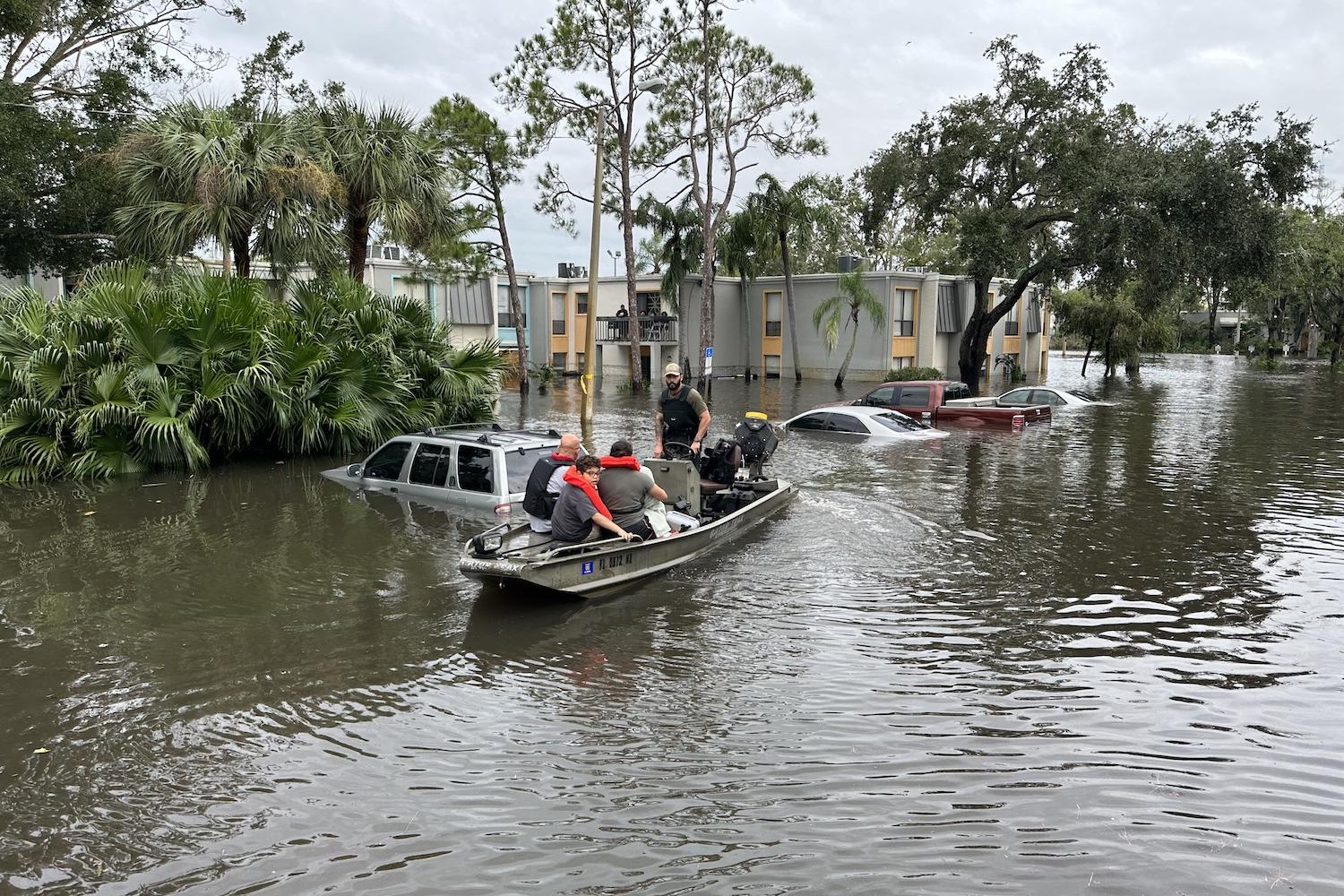
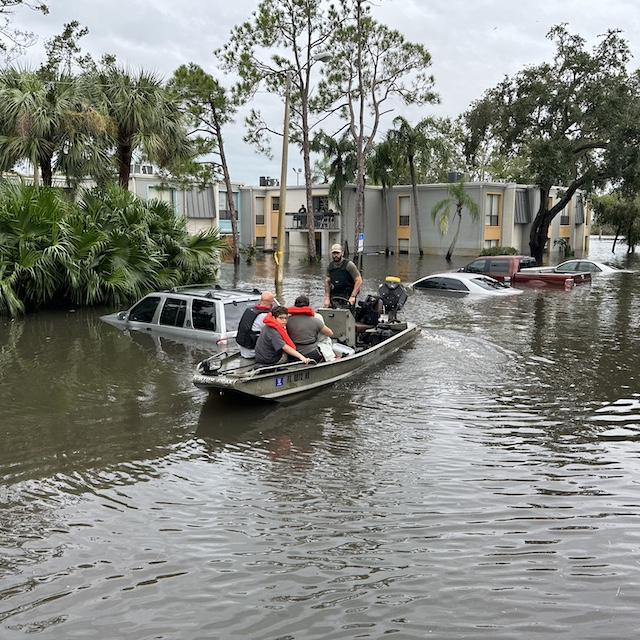
A Florida Fish and Wildlife Conservation Commission officer helps people get out of a flooded area after Hurricane Milton. (Image: Florida Fish and Wildlife Conservation Commission/Flickr)
The devastation from Hurricanes Helene and Milton and other extreme weather events makes climate resilience more critical than ever. This urgency is amplified by communities' ongoing efforts to recover from the intensifying impacts of climate change, which disrupt lives, dislocate livelihoods and cause substantial economic damages. Climate resilience, in this context, refers to the ability to prepare for, recover from and adapt to these impacts. As a pioneer in the field, I see that understanding and implementing climate resilience is gaining traction, but the pace must accelerate to keep up with the escalating frequency and severity of these events.
The impact of hurricane events and other natural disasters, along with the $28 billion disasters recorded in 2023, underscores weaknesses in infrastructure, social systems, and economies, highlighting a growing shift towards resilience measures. This shift is driven not only by the increasing visibility of vulnerabilities but also by the growing focus on federal climate-related programs, local community initiatives, and the recognition by corporate America that resilience is crucial for their bottom lines, employees and the communities they serve.
At the federal level, several programs are spearheading efforts to enhance climate resilience. The National Climate Assessment, for instance, provides a comprehensive analysis of climate change impacts across the United States, guiding policymakers to better understand and address risks. FEMA’s Building Resilient Infrastructure and Communities program is another critical initiative, offering funding for pre-disaster mitigation projects and encouraging communities to invest in resilient infrastructure.
Similarly, the Climate Resilience Toolkit, developed by the National Oceanic and Atmospheric Administration, equips communities with resources to assess vulnerabilities and plan for resilience. And the Infrastructure Investment and Jobs Act marks a significant legislative milestone, dedicating over $50 billion to climate resilience investments, from upgrading infrastructure to enhancing the resilience of water systems and power grids.
Corporate America’s role in advancing climate resilience cannot be overlooked. Companies are increasingly integrating climate risk into their strategies, driven by the need for long-term sustainability. They are assessing the potential impacts of climate change on their operations, supply chains, and assets, and developing strategies to mitigate these risks.
This proactive stance is partly due to growing investor pressure demanding disclosure of climate risks and resilience strategies. Governments are also implementing regulations that push companies to address these risks, with the Securities and Exchange Commission proposing rules requiring disclosure of climate-related risks. Moreover, many businesses are embracing resilience as part of their broader corporate social responsibility efforts, investing in resilient practices to enhance their reputation, attract customers, and support their employees and communities.
Some major corporations are leading the way. Microsoft, for example, supports disaster preparedness through its AI for Earth program, while Walmart is working to make its supply chain more resilient by collaborating with suppliers to reduce emissions. And Bank of America integrated climate risk into its lending and investment decisions, ensuring that its investments align with resilience and sustainability goals.
Cities and states are also taking proactive measures to build resilience. Miami, with its vulnerability to sea-level rise and hurricanes, launched the $400 million Miami Forever Bond to fund resilience projects like upgrading stormwater systems and raising roads. Louisiana, facing unique geographic challenges, developed a Coastal Master Plan for restoring and protecting its coastline — alongside initiatives such as the Louisiana Watershed Initiative and a comprehensive Climate Action Plan.
In New York City, the OneNYC 2050 plan aims to strengthen coastal defenses, upgrade infrastructure, and improve emergency preparedness, with the East Side Coastal Resiliency Project focusing on protecting vulnerable neighborhoods. California, a state at the forefront of resilience efforts, implemented the Safeguarding California Plan, investing in wildfire prevention, water conservation and sustainable agriculture.
Other notable efforts include Norfolk, Virginia’s resilience strategy, which addresses the city’s vulnerability to sea-level rise through projects that elevate homes, improve drainage systems and create green spaces to absorb floodwaters. And Austin, Texas' focus on reducing its carbon footprint and enhancing the resilience of its water supply through its Climate Resilience Action Plan.
Despite these efforts, more attention is essential to scale up climate resilience initiatives. Public education is vital to raise awareness and garner support for resilience investments. Policymakers must advocate for resilience investments through business tax incentives and grants for infrastructure upgrades. Public-private partnerships are crucial to drive innovation and ensure comprehensive and effective resilience measures.
Engaging communities in resilience planning is equally critical. Resilience strategies must be inclusive and participatory, involving community members in decision-making processes to ensure that measures are tailored to their specific needs and contexts.
Ultimately, building resilience isn’t just a technical challenge. It’s a social imperative. It requires collaboration, innovation, and a commitment to equity and sustainability. To meet the escalating threat of extreme weather, we must accelerate our efforts to build a more resilient future.
3 Signs Momentum is Building For Business to Act On Nature


(Image: Jelle de Gier/Unsplash)
Nature was a major focus at Climate Week in New York City last month — from the World Biodiversity Summit to the Nature Hub and the Nest Climate Campus. All for good reason: Nature action must go hand in hand with climate action for the long-term stability of the planet’s health and the resilience of the global economy. Reversing nature and biodiversity loss cannot be achieved without tackling climate change, and vice versa.
Critical mass on the need for nature action has finally been reached by investors, companies and governments alike. This reckoning will be top-of-mind as world leaders and members of the business and nonprofit communities gather in Cali, Colombia, for the U.N. Biodiversity Conference (COP16) this week to discuss progress toward ambitious goals for protecting and restoring nature and ecosystems around the globe. These three takeaways from Climate Week show signs that momentum is building in the private sector to address nature and biodiversity loss alongside climate change.
1. The business case for nature action is clear
Like climate risk, the evidence is mounting up that nature is a material financial risk. While more than half of global gross domestic product — some $44 trillion in economic value generation — is moderately to heavily reliant on nature and its services, protecting nature could prevent a global GDP decline of $2.7 trillion annually by 2030. And businesses worldwide are increasingly being held accountable for their contributions to nature’s degradation – from 3M’s $10.3 billion settlement over its contamination of water systems, to the global opposition to JBS’ plan to list on the New York Stock Exchange due to deforestation linked to the company's cattle sourcing from Brazil.
The result? Much of the discussion at Climate Week was no longer focused on the business case for nature action, but on how the private sector can address the escalating risks posed by the nature crisis.
2. There are growing resources to support private sector action
According to estimates, private-sector investments that harm nature amounted to at least $5 trillion in 2022. That's 140 times more than private funding for nature-based solutions. A report published during Climate Week seeks to help the private sector in righting this imbalance by providing a framework for redirecting financial flows in support of global biodiversity goals.
In another recent development, the Taskforce on Nature-related Related Financial Disclosures published guidance on how its recommendations map with other leading standards, such as the International Sustainability Standards Board, Global Reporting Initiative 10: Biodiversity 2024, and the European Sustainability Reporting Standards. The disclosure recommendations aim to help companies and investors better understand and report their nature-related impacts, dependencies, and opportunities to inform their nature strategies and spur action.
3. More companies and investors are acting on nature
With an eye toward COP16, many organizations were on the ground in New York City showcasing the growth of their nature initiatives and previewing their plans for the upcoming biodiversity summit. Marking the momentum behind its disclosure recommendations released a year ago, the Taskforce on Nature-related Related Financial Disclosures (TNFD) said it plans to announce the next cohort of early adopters at COP16. More than 440 organizations, representing over $6 trillion in market capitalization among publicly-listed companies and over $16 trillion in assets under management among asset owners and managers, are already early adopters to the TNFD framework.
Nature Action 100, the first global investor-led engagement initiative to address nature and biodiversity loss, also announced plans to reveal the results of the initiative’s first benchmark assessments of 100 companies’ progress toward key investor expectations on nature at COP16. Since kicking off direct engagement with companies following Climate Week last year, more than 230 institutional investors with nearly $30 trillion in assets under management or advice are now participating in Nature Action 100 to support greater corporate ambition and action on nature.
Business for Nature published a letter to government heads signed by over 180 businesses and financial institutions calling for renewed policy ambition to implement the Global Biodiversity Framework adopted at the COP15 summit and reverse nature loss this decade. The organization also posted a Countdown to COP16 infographic, illustrating the critical actions businesses and governments are taking to turn the tide on nature’s destruction.
These important takeaways provide valuable insight into how the private sector is mobilizing to mitigate nature risk in tandem with climate risk ahead of COP16. And they signal why events like Climate Week and beyond will increasingly feature broader conversions about how the world can reach a climate-resilient, nature-positive, and water-secure future.
Ethical Sourcing Campaign Sows the Seeds of Change for Fairtrade Farmers


Fairtrade cocoa farmer Salamatu Katta is featured in a mural on the Leevers Locavore grocery store in Denver, Colorado. (Image courtesy of Fairtrade America.)
Salamatu Katta is a 29-year-old cocoa farmer in Sierra Leone breaking down gender and generational barriers by taking over her father’s cocoa farm. She cultivates her crop organically as part of the Munafa Cocoa Farmers’ Cooperative. What made a difference for Salamatu’s small business — with ripple effects for her community — is that she is a Fairtrade farmer. Now, her image is emblazoned on a huge mural outside a Denver, Colorado, grocery store, bringing her story to American consumers.
Katta’s mural is one of three murals across the United States that are part of Fairtrade America’s annual Fairtrade Month campaign. It connects shoppers, grocers, brands and farmers to celebrate their roles in enabling the Fairtrade system to thrive.
This year’s campaign is focused on ethical sourcing. Each mural depicts a farmer who grows Fairtrade-certified coffee or cocoa sold inside the store. For Katta, the cocoa she grows is an ingredient in products from chocolate company Hu Kitchen. In Boise, Idaho, the cocoa grown by Francisco Contreras and Carlixta Contreras Martínez is an ingredient in products from Navitas Organics. And in Buffalo, New York, the coffee grown by Ibu Rahmah is an ingredient in products from Gimme Coffee.
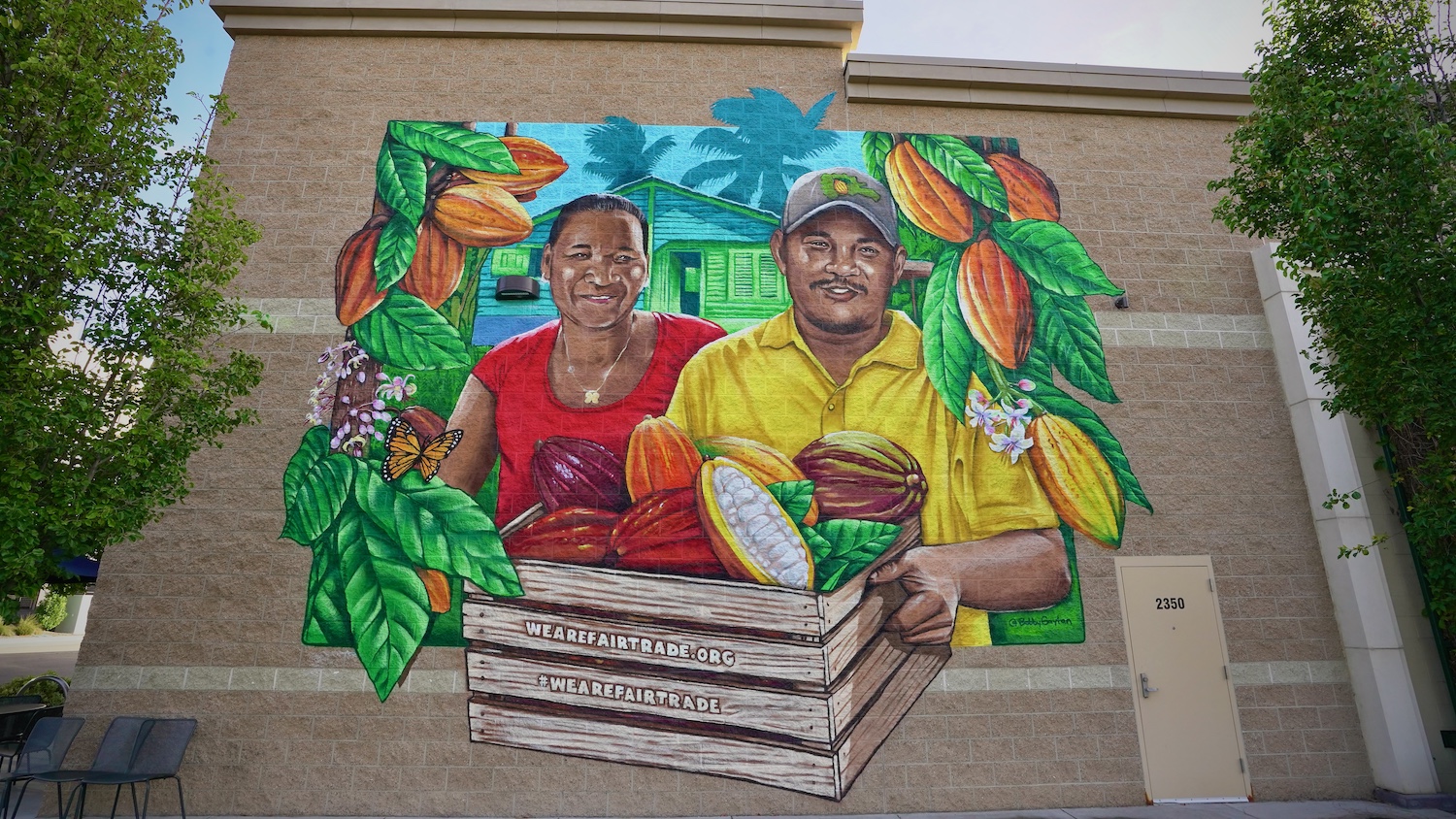
Beyond the colorful murals is the broader effort by Fairtrade America and the 70 U.S. Fairtrade-certified brands to support equity for farmers as they strive to create sustainable livelihoods for themselves and their communities, often against significant odds. There are over 2 million Fairtrade farmers and workers in certified cooperatives around the world. The certification ensures that products are grown in a way that supports sustainable livelihoods and safe working conditions, among other requirements.
“Storytelling is a really interesting and compelling way to encourage folks to slow down a little bit and think about other folks,” Kate Stritzinger, Fairtrade America’s director of marketing and impact, told TriplePundit. “The 'We are Fairtrade' campaign closes the gap between consumers and farmers. That's really the intention behind it.”
The three new murals join twelve others from previous years. Retailers that receive murals report a 75 percent increase in sales on Fairtrade products year after year, Stritzinger said. The organization also measures the potential reach of the campaign across all Fairtrade brands and retailers. In 2023, that was 70 brands and 2,000 retailers in the U.S. and Canada, and Fairtrade found that 92 percent of consumers show interest in learning more about the people who grow their food.
Fairtrade aligns with brand values
For Hu Kitchen, one of the participating brands in the 2024 campaign, celebrating Katta is emblematic of the company’s mission to support farming cooperatives and the livelihoods and communities they represent. Hu Kitchen sources 100 percent of its cocoa, coconut sugar, cashews, vanilla and quinoa on Fairtrade terms.
“By sourcing ingredients that are Fairtrade certified, we're hoping to better support the livelihoods of these Fairtrade farmers that grow the ingredients that make Hu products possible,” said Daniel Klausner, director of commercial strategy and impact for Hu Kitchen. “We've seen firsthand the positive impact that certification can have on the farming communities.”
The benefits of the Fairtrade system for brands and farmers fall into three buckets. First, Fairtrade farming organizations earn at least the Fairtrade Minimum Price, which varies based on things like the product, the quantity and the region it is grown in. That standard acts as a safety net for producers when the market prices are low and is especially important at a time of great market volatility in food prices.
“All of the stakeholders in the food system deserve fair pay, but some have more power in dictating their terms,” said Andrew Beck, director of procurement at Hu Kitchen. “Farmers often have the least power and as such they earn less than is fair. And often, that means less than is needed to reinvest in their farms or their families … When farmers aren't treated equitably, supply chains fall out of balance, and ultimately, that impacts everybody along the way, including customers.”
Farmers also receive the Fairtrade Premium, an additional sum of money that farmers and workers invest in projects of their choosing. The premium is calculated as a percentage of the volume of produce sold, and cooperatives decide democratically how they want to reinvest. That could be in more training and development or resources to improve farms and local communities, such as a seedling nursery, a new road or bridge, a health clinic or a maternity ward. In 2022, the Fairtrade Premium reached a record high of about $240 million USD.
And not least, by having the Fairtrade mark on their products, brands show a commitment to the system, with the aim of expanding the network to more brands and more farmers who can benefit.
Since Hu Kitchen was Fairtrade certified in 2021, it has paid more than $1 million in Fairtrade premiums across all of its ingredients, Beck said. “That’s a million dollars that have gone to farmers like Salamatu and her community,” he said.
Katta is a member of the Munafa Cocoa Farmers’ Cooperative, which cultivates all of its cocoa organically. Her cooperative opted to use its premium to cover the cost of underbrushing work on the farms. Underbrushing is the process of removing weeds that compete with cocoa trees for water and nutrients. Katta also created economic opportunities for members of her community by hiring them to do the work.
“Salamatu has dreams of being an entrepreneur that can support not just her own future, but the future of her community, and we are glad to be supporting that,” Klausner said.
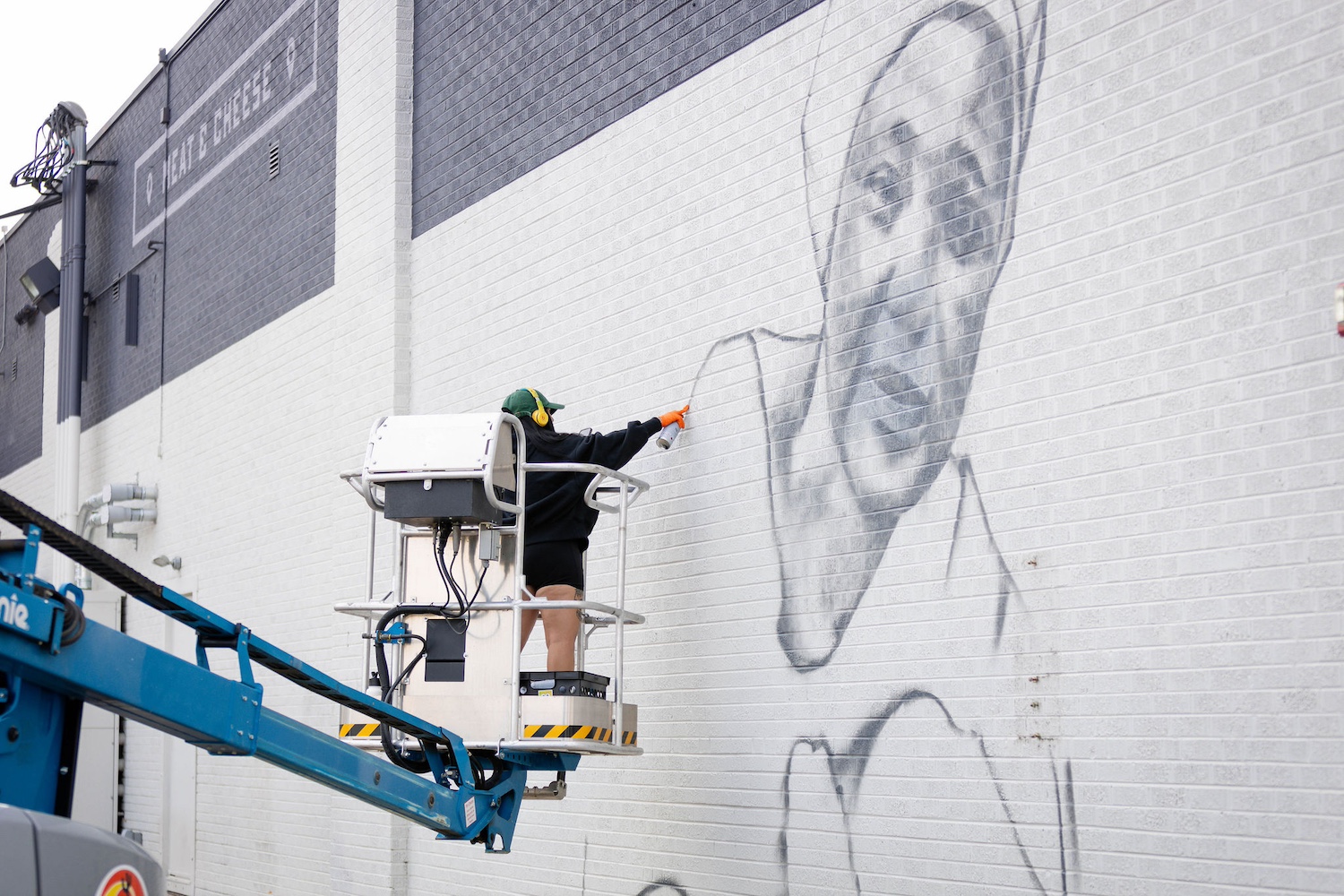
"This isn't just for big brands"
On a mural outside the Lexington Co-op grocery store in Buffalo, New York, shoppers can learn about the coffee grown by Ibu Rahmah that’s sold inside. Gimme Coffee, an employee-owned cooperative based in Ithaca, New York, that sells specialty coffees, sponsored the mural. Of all the coffee they source, 95 percent is certified Fairtrade.
Highlighting Ramah’s story is an opportunity to underscore why Gimme Coffee chose to be Fairtrade certified.
“Frankly, this makes us an anomaly in the specialty coffee world,” said Colleen Anunu, co-managing director and head of product development at Gimme Coffee. “But we want to put this in front of customers to say this isn't just for big brands. This is a tide that lifts all ships. That’s why we engage with Fairtrade the way that we do.”
Ramah is “a total powerhouse, a standout individual,” Anunu said. “She has had to combat gender inequity in a region that doesn’t allow women to own certain lands or make decisions about agricultural production and. in many ways, are treated like the property of their husbands. For Ibu Ramah to own her own business is a phenomenal feat. She has pushed the culture to allow women to own coffee trees, to own bank accounts, to have say in decision-making in their households and how they spend their money and how agriculture production is brought to market. She has done so much for that area.”
Support of Fairtrade farmers is also a reflection of Gimme Coffee’s own democratic structure as an employee-owned company, Anunu said. “As a cooperative ourselves, it's super important to us that we're also working with suppliers that have democratic control through its membership in cooperatives. The Fairtrade brands have no influence over how the farmers spend their money from premiums. It really is a community-led effort.”
One part of the solution to a multifaceted problem
Taking part in the Fairtrade system has direct, positive impacts on farmers’ livelihoods, but it is just one solution to the multifaceted challenges facing farmers and communities in many places around the world.
The global food system is complex, exacerbated by issues like climate change and global instability. Massively insufficient infrastructure like roads and bridges or communities struggling with intergenerational poverty are issues beyond the scope of what an organization like Fairtrade can resolve.
“But our work with Fairtrade is a step in the right direction,” Beck of Hu Kitchen said. “We know that putting more money in farmers' pockets allows them to invest where they believe they should be investing and supports their livelihoods best. That’s something we stand behind fully.”
Fairtrade America's Stritzinger seems to agree. “When you think about the chronic underpayment of farmers, the increased impact of climate change, and the prevalence of corporate greed here in the U.S., the problems farmers face are getting bigger,” she said. “And we haven’t even fixed it at the root level, which we see as pricing. So, we have to build the ship and sail it at the same time. Farmers know what they need. They just need the resources to tackle the problems themselves. They're way closer to the problems and to the solutions.”
On the consumer side, getting more people to buy Fairtrade products is about access and visibility, Stritzinger said.
“Our research shows that when consumers get the choice, they choose Fairtrade,” she said. “We’re a known entity. We’ve seen a 118 percent increase in awareness of Fairtrade in the U.S. in the past four years alone … We’re optimistic that once we get more products on shelves, we can deliver more impact for farmers.”
The Time Off to Vote Movement is Growing, But Obstacles Remain


(Image: bizoo_n/Adobe Stock)
The long lines at early voting locations across the U.S. in the run-up to Election Day are a highly visible reminder that many voters need to excuse themselves from work for hours at a time just to cast their ballots. Employers can help to resolve the problem by offering paid time off for voting. Still, significant barriers will remain until all voters have an equal opportunity to cast their vote.
The business case for paid time off to vote
Advocates for paid time off emphasize that improvements in employee engagement and talent recruitment balance out the expense of lost working hours. For example, ahead of the U.S. midterm elections in 2022, the CEO of the advertising and marketing agency Red Branch Media penned a powerful op/ed outlining how paid time off for voting has “more than paid for itself in recruitment, retention and hiring” at the company.
“When employees feel like their voices are being heard and that their opinions matter, they’re more likely to be engaged in their work. This leads to better performance and higher productivity,” Red Branch Media CEO Maren Hogan explained.
In the years since, the paid time off movement has grown considerably. “The idea that employers can and should provide their employees time off to vote has gained significant momentum in recent years, evolving from a niche perk to an expected benefit in many industries,” Lars Schmidt, founder of the human resources consulting firm Amplify, wrote in an article for Fast Company this week.
As time off for voting becomes a new standard for employers, some consider the paid leave movement a natural evolution of corporate social responsibility — particularly since less than half of U.S. states mandate paid voting leave. Schmidt echoes that sentiment, describing the movement as a permanent fixture, “driven by a combination of employee expectations, brand considerations, and a growing recognition of the link between civic engagement and workplace satisfaction.”
Business leaders can give themselves at least part of the credit for building momentum toward paid time off. In 2018, hundreds of corporations representing approximately 2 million workers launched the Time to Vote organization, focusing on an employer’s opportunity to make a difference by providing paid time off for voting.
Time to Vote launched with roughly 400 corporate members, which grew to 700 by 2020 and tops 2,200 today — more than double the organization’s initial goal of 1,000 participants. Meanwhile National Voter Registration Day, an annual campaign supported by large companies like Aflac, Microsoft, Paramount and Target, helped to get more than 5 million people registered to vote since it launched in 2012.
Even if they have the day off, why should anyone wait for hours to cast a ballot?
Despite these corporate efforts, the question remains: Why must any voter in modern America — with paid time off or without — stand in line for hours to cast a ballot while others can breeze in and out of their polling place with practically no wait, or simply mail in their ballot or drop it off?
While the bipartisan Presidential Commission on Election Administration agreed a decade ago that no one should have to wait in line for more than 30 minutes to vote, about a fifth of voters faced longer waits when casting their ballots in 2020, according to the MIT Election Data and Science Lab.
State laws often contribute to the wait times people see on Election Day. “Long waits at polling places are disruptive, disenfranchising, and all too common. Black and Latino voters are especially likely to endure them,” a research team at the Brennan Center for Justice found in a 2020 report.
In particular, communities with fewer poll workers, voting machines and other election resources tend to experience longer waits. When states reduce the number of polling places, limit early voting or make it more difficult to vote by mail, it adds pressure that leads to longer wait times. Voters waiting in long lines are also especially vulnerable to political violence, the Brennan Center for Justice found.
While a 2022 study suggests that paid time off can motivate people to stand in line regardless of the waiting time, some workers are left out of paid leave policies altogether.
“Workers of color, particularly women of color, are more likely to face unpredictable and challenging schedules, potentially compounding the growing racial voter turnout gap,” Molly Weston Williamson, a senior fellow with the Center for American Progress, wrote in the report.
In addition, convenient access to a polling place also varies considerably depending on the voter’s ability to work at or close to home, in contrast to others who commute long distances to work far from their local polling place. An additional dividing line exists between gig workers and self-employed individuals who can afford to give themselves time off to vote, and those who can’t afford to lose valuable time at work.
Paid leave or not, long lines also disproportionately impact voters who are less than able-bodied, or who have small children or other dependents in their care.
Altogether, these barriers to voters indicate that paid leave is an important but insufficient contribution to voting rights in the U.S. Employers who participate in the paid time off movement can build on their efforts by advocating for ballot access on a more holistic basis, including a more equitable distribution of in-person polling places as well as mail-in voting, drop-boxes, and other election reforms that help close the gap between voter registration and voter turnout.
17-Year Partnership Between Subaru and the ASPCA Has Helped Over 134,000 Pets


Lots of people say they stand up for underdogs. But not everyone welcomes them into their showrooms. That’s what some Subaru retailers do every October as part of a 17-year partnership between Subaru and The American Society for the Prevention of Cruelty to Animals (ASPCA).
More than 600 Subaru retailers work with animal shelters in their communities, even holding adoption events in their showrooms. Through the Subaru Loves Pets program, they provide funds and supplies to shelters and cover adoption and vet costs for pets seeking loving homes. New owners are presented with Pet Parent kits curated by Staples and Bark, which include supplies they will need for their new family member.
As the largest corporate sponsor of the ASPCA, Subaru has donated more than $38 million to the organization throughout their partnership and helped to treat, transport, rescue, and home more than 134,000 animals across the United States.

Just this year, Subaru and its retailers provided more than $3 million in direct funding through grants administered by the ASPCA to help get animals ready for adoption.
“We’re very selective with whom we partner. When we were invited to participate in the Subaru Share the Love Event, it quickly became clear that there were shared values,” said Matthew Bershadker, president and CEO of the ASPCA. “Subaru understands the importance of being a good corporate citizen, not just for customers, but the importance of doing good as a business.”
Not to mention that Subaru is a highly regarded and visible company, which made it a natural choice. “It’s a household brand name with a sterling reputation, not just for its products, but how it conducts itself,” Bershadker continued.
Just like the nonprofit, Subaru is driven to find all pets a loving home. Shelters house about 3.3 million dogs and 3.2 million cats across the United States, according to the ASPCA. Through the Subaru Loves Pets program, the automaker and its retailers have committed to improving the lives of as many shelter animals as possible.
“This is a partnership rooted in the alignment of values, which benefits the community and saves lives through our shared goals,” Bershadker said. “We are grateful for our longstanding partnership with Subaru.”
Both the ASPCA and Subaru are especially passionate about helping overlooked “underdogs” (older or disabled shelter dogs) find loving homes. Subaru created National Make a Dog’s Day, which annually takes place on October 22, for dog owners to spoil their pets and encourage people to foster or adopt underdogs.

“They are older, they sit in shelters longer and many are victims of abuse,” said Bershadker, who fostered and adopted an underdog himself. “Some have medical and behavior problems. Subaru is helping people to see these animals in a different light.”
The ASPCA uses science-based behavior programs to help abused animals recover from their trauma. “Their capacity to forgive and trust humans again after they have suffered is amazing,” Bershadker said.
Bershadker recently adopted an underdog named Whiskey, who came to the ASPCA as a victim of abuse and neglect, with her hair knotted, wounds down to the bone and requiring the removal of more than 20 teeth. Bershadker started fostering her in January, and when she was officially surrendered to the ASPCA in March, he adopted her. Since then, she has grown from seven pounds to almost 10. “She is the type of dog Subaru is helping us celebrate,” he said. “The most difficult adoptions are especially great because we know these animals are finally getting the second chance they deserve.”

Adoption events also have a ripple effect on shelters, he added, freeing up critical resources to help the remaining animals and opening space for others. They also influence how people think about and treat animals, after seeing how some of them have suffered.
The helping hand is needed as animal welfare agencies work to recover from the pandemic, which stretched limited resources thin. “Many of the shelters are still at or near capacity,” Bershadker said.
Pet adoptions did not soar during the pandemic as numerous people believed. Instead, many shelters housed and fostered pets while their owners were sick with COVID or faced financial setbacks.
“We did a fair amount of emergency boarding,” Bershadker said. “The cost of vet care, the lack of access to vet care, a shortage of veterinarians and vet technicians, and limited pet-friendly housing, as well as economic uncertainty, made caring for a pet difficult."
Those challenges for shelters and the people and pets they serve continued as costs of living rose over recent years. “The country is still struggling. Shelters are continuing to lean into fostering, and some shelters started programs to help keep pets in homes,” he said. “One or two things go wrong [for a family], and the safety net fails them. You can see the power of human-animal bonds and how it helps people heal.”

Not only does the partnership with Subaru raise awareness about the plight of animals in shelters, but it also helps celebrate those human-animal bonds, Bershadker added. “I love the local reach the partnership brings,” he said, referring to Subaru retailers working with local shelters. “We’re all trying to change the fate of animals together.”
This article series is sponsored by Subaru of America and produced by the TriplePundit editorial team.
Why Incremental Change is Everything When It Comes to Sustainability for Fashion Brands


The British retailer M&S offers in-house repairs, a beauty product takeback program, and a clothes donation program as a part of its Plan A: Another Life circularity initiative. (Image courtesy of M&S.)
In August, the British retailer M&S made headlines with the launch of its new service for clothes repairs and alterations. It’s a new direction for a retailer that not so long ago led the sector on sustainability with its bold Plan A program — an internal plan to be more sustainable — but which has since been quieter on the subject of sustainability.
The announcement put the spotlight back on the issue of sustainability in the fashion sector.
That’s a topic its always struggled with. Fashion is the second biggest user of water. It accounts for 10 percent of all carbon dioxide emissions. The Ellen MacArthur Foundation estimates that a truckload of abandoned textiles is dumped in landfill or incinerated every second.
While few would deny these facts, actually doing anything about it is far harder. Other sectors can talk frankly about chemicals, wages, microfibers and so on. But it sits too awkwardly with the glossy, beautiful world of fashion. Quite simply, too much honesty can derail the dream many fashion brands sell.
At the same time, it’s not certain that transparency will have the desired effect. By adding the facts and figures, are you really going to stop someone from buying an article of clothing when they fall in love with it on social media and make a special trip to the store to purchase? It’s little wonder that the 2022 Fashion Transparency Index calls for more transparency from the world’s largest fashion brands about their social and environmental efforts.
This has to change. Fashion companies can no longer continue to ignore the issue of sustainability. While they may be able to avoid public censure or legal penalties, and clever ad campaigns may help them sell even the most unsustainable products, this is temporary. And the far greater issue is the missed opportunity. The brands that act now to become more sustainable and more ethical will see significant long-term value.
Language, small steps and transparency
So, how do they start? What can they do to make a meaningful difference while not alienating vital customers? They can make major and fairly rapid wins by acting in three areas.
First, move away from calling audiences consumers and talk about them as people or citizens with choices and voices. Our culture of consumption is not sustainable, and brands using the term consumers assume that someone is going to buy from them. Words matter, and changing their language is an important first step in changing mindsets and perceptions.
Second, look for small, tangible steps. Move past the paralysis caused by the sheer scale, complexity and importance of sustainability. Incremental change can be significant if it is properly aligned with measurable goals around long-term well-being for all. For example, add a target number of wears to a garment’s label. That one small step could start to change the “one and done” mentality of fast fashion.
Third, be more transparent without overwhelming consumers at the point of sale. Provide sustainability efforts in a digestible format, such as on websites, social media, or through dedicated optional sustainability initiatives, including repair services.
Time to act
These are just three steps, but they have real impact. And we’re already seeing fashion companies lead the way. Look at Vivo Barefoot, which incorporated repairability into its DNA from the beginning. Or look at what M&S is doing. Repair and reuse is a key area. The conversation needs to shift from recycling to reuse, tackling the problem at its source.
Nobody’s Child is a good example of a fashion firm considering the whole supply chain. It’s transparent about its direct suppliers, which is a good start, and all of its fabrics are at least 75 percent reduced-impact alternatives. It’s not perfect, but the company is transparent about its efforts, not making wholesale claims.
More fashion companies need to find ways to lead in this space. If they wait for others to lead, they’ll miss a vital opportunity. The graveyard of history is full of once vast companies that hung back on the big issues of their day, waiting to see what competitors would do.
The key point with sustainability is that sharing something is better than sharing nothing. No brand is perfect, but the effort they make to improve is what tells the story.